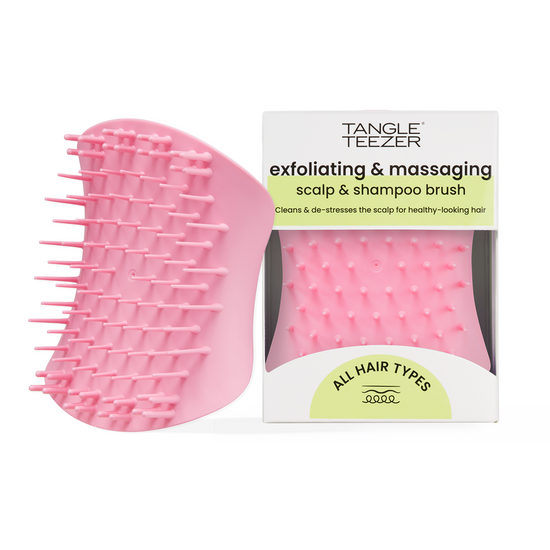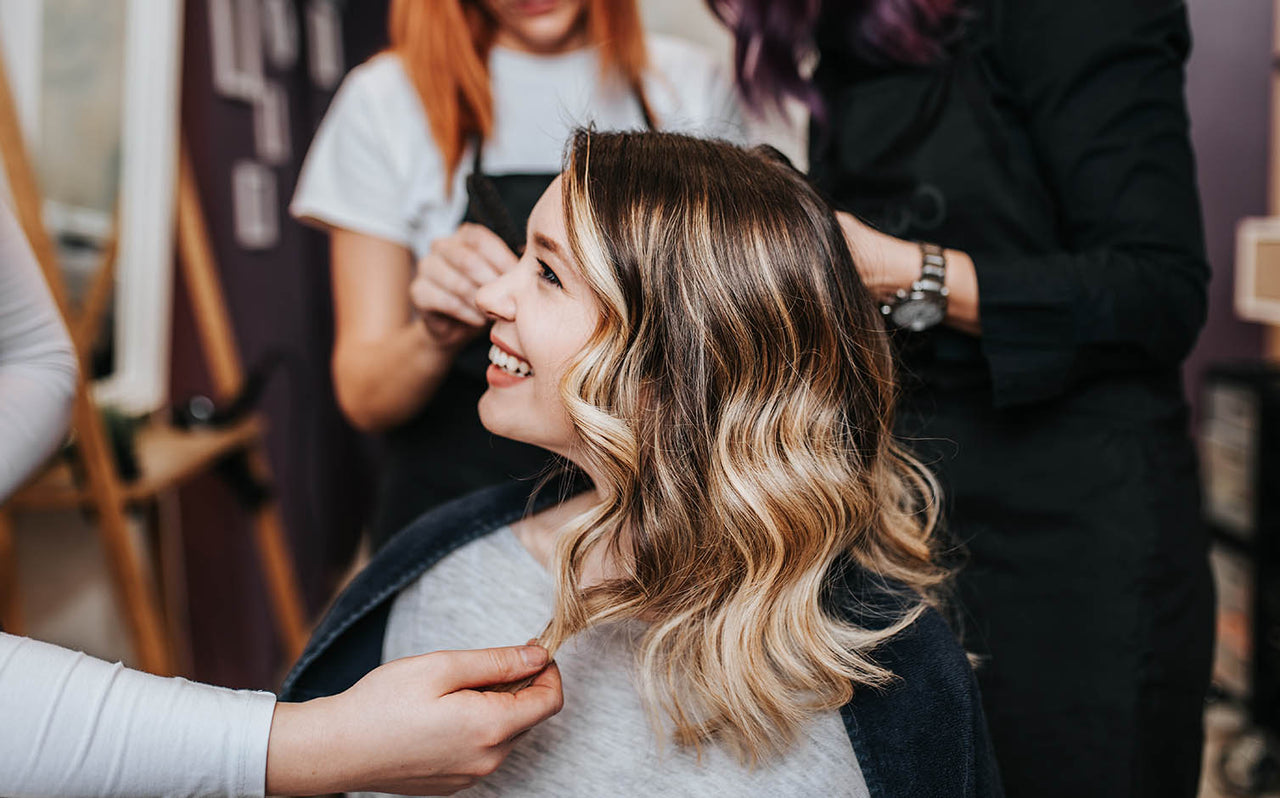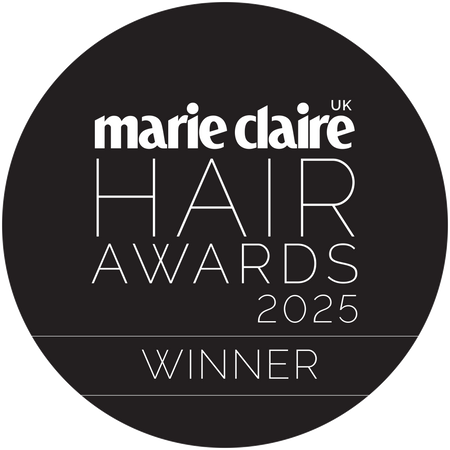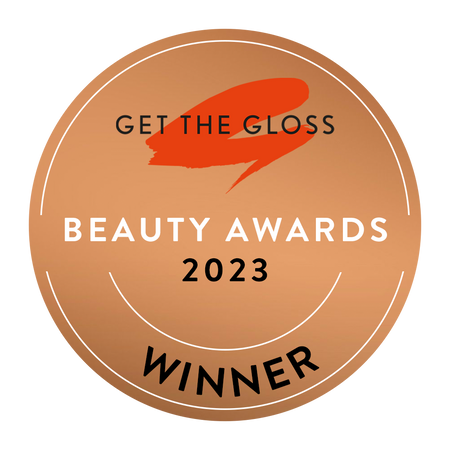Dyeing your hair is one of the easiest ways to freshen up your look and change up your style, but the vast majority of us still want our mane to have that au naturel vibe - even if it’s courtesy of a trip to the hair salon.

Balayage and ombré are two words you will often hear when in pursuit of a low-maintenance, ‘I woke up like this’ hair color look, with darker roots and lighter ends. But what do they actually mean and how do you choose which one to go for? Here we’ll walk you through the difference between balayage and ombré, so you can strut in to your next salon appointment with confidence and be sure your stylist is taking the right approach.
What is balayage hair?
Well, first things first - strap yourself in for a modern languages lesson. Balayage is a French word meaning “to sweep” or “to paint”. It basically involves your colourist hand painting soft pieces of colour on to your hair from root to tip. The result? A super natural, sun kissed style that will have you looking like you spent the Summer in St Tropez. The dye or bleach becomes more saturated towards the tip of your hair, whilst the roots retain more of their natural colour. Because the highlights are softer at the root, regrowth lines are less obvious, making it the ideal option if you want a fresh, intentional look that doesn’t require lots of upkeep. Another benefit of this approach is that you can decide how “lived in” you want your hair to appear. Balayage gives your colourist the control to start painting further away from the root for that cool, grungy vibe or for a more complete highlight, they can simply start closer to your root. Unlike traditional highlights, balayage doesn’t require tons of foil or hours spent sitting under the heat - which is great news for your hair’s health. Find out more about what is balayage hair here.

What is ombré hair?
Ombré and balayage may be different styles, but they have a bunch of similarities. Firstly, ombré is another French term - but this one means “to shadow” or “to shade”. ombré is also another hair painting technique that results in darker roots and lighter tips - which means another win for “Team Low Maintenance”. However, when you ask for ‘ombré’ the colourist will usually keep the hair darker from the roots to about half way down your hair, before introducing the lighter colour, which they will carry on through to your tips. It tends to be a bit more of an obvious look compared to balayage and can be the perfect option for brunettes wanting to make the transition into blonde life or, to introduce a crazy, cool colour like purple or silver into your hair in a softer subtler way.

What is the difference between ombré and balayage hair?
With all the similarities, it’s totally understandable if you get a bit confused between the two! However, for you to be able to colour with confidence, it’s important to get your head around the key differences between these two equally gorgeous techniques.
Style vs Technique
Ok, so first things first (and we don’t want to confuse you any further) but in reality, the two are not even comparable terms. Ombré is actually a style and balayage is technique. The sought after ‘ombré’ style is that graduated colour going from light to dark as you travel up the hair (or dark to light if you’re going for a reverse ombré). Balayage is a technique used to achieve an ombré look - however, nowadays both stylists and customers do use the two words to describe different styles.
Drama vs Delicate
One of the biggest differences in the end result of balayage vs ombré is that the drama levels differ considerably. With balayage, the aim is to create a natural style that blends in with your natural roots, lightens the hair with thin, subtle highlights and ultimately gives you a sun kissed look that doesn’t look like it came from a bottle. Ombré on the other hand tends to be a bit more of a head turner. The colour starts lower down, away from your roots and, whilst still graduated, tends to have a more obvious, dramatic fade line (the part of your hair the colour starts to transition).
Vertical vs horizontal
These different final styles are achieved by two slightly different approaches - and a lot of it comes down to the direction that the colour is applied. Ombré is generally done by placing the lighter colour being placed horizontally on the fade line and being blended upwards to make the line appear more gradual and diffused. The lower section is then given pretty much full saturation for that eye catching dip-dye effect. With balayage, the process is more delicate. Small, subtle sections are painted directly with the colour vertically - going as close or as far away from the roots as your desired look requires!
Despite these differences, both techniques are highly specialised and can require a lot of time at the salon, so make sure to clear your afternoon! You can also combine the two techniques for a highly gorgeous hybrid look.
How long does balayage last?
Balayage truly is a gift for anyone that doesn’t want to spend lots of time (or money) maintaining a beautiful blonde look all year round. Whilst traditional highlights require touch ups every 6-8 weeks, with balayage you can get away with visiting the salon every 4 months or so. Because of the soft, natural application at the roots, your regrowth never really looks bad! Rather than that dark, obvious line you get with highlights, your balayage will gently blend in with your natural hair colour, so even after a few months or regrowth you’re still looking fabulous.
How to do a balayage at home?
So we know that balayage is a low maintenance look that could limit your trip to the hair salon - but is it something you can achieve at home? Well, this sun kissed look involves bleach, so if you’re not confident with that level of hair dye responsibility it may be best to stick to the professionals. However, the technique is possible to recreate on your own, so if you’re feeling bleach brave, DIY balayage is pretty easy! Visit our article on the 'ultimate guide to balayage hair' to find out more about the hair trend.
1. Pick you colour - and make sure to do an allergy test 48 hours beforehand.
2. Section your hair using the 'hot cross bun' technique. Divide your hair into 4 sections by running a comb down your centre parting and then across horizontally from ear to ear.
3. Before you start, you’ll want to apply a barrier cream (Vaseline is our go-to) around your hairline to avoid any staining.
4. Now it’s time to get your dye on. To achieve the balayage effect, you only want to apply your colour to the lengths of hair you want to lighten - and for that au naturel look, don’t go too close to your roots.
5. Work on small sections at a time - you can use grips to secure hair out of your way whilst you get to work.
6. Whilst balayage means ‘to paint’ and usually involves a brush - you can get the same soft effect at home using your fingers! Apply your colour carefully, blending the colour using sweeping downward strokes. You can control how much of your natural root colour you leave out.
7. Work through each small section at a time and keep going until your whole head is complete and your ends are saturated to your satisfaction
8. Wait and rinse! Follow the instructions on the packet of your chosen colour and then rinse to reveal your fresh balayage look! Make sure to use a hydrating treatment when afterwards to ensure your hair feels as good as it looks.
How long does ombré Hair Last?
Like balayage, ombré lasts a lot longer than standard highlights - and is definitely still a look that requires minimal maintenance. However, you may find that balayage allows you to have a bit more time between salon visits. As ombré is more of a dramatic look, it can need more attention to stay looking its best and stay looking balanced. Generally it’s recommended to get your colour topped up every 2-4 months - but this really depends on the speed at which your hair grows, the colours you are using and how comfortable you are with a more ‘lived in’ look.
How to do ombré hair at home
Want to take your ombré makeover into your hands? Whilst, like balayage, it’s a good idea to turn to a stylist if this is your first time dyeing your hair, if you do want to try the look at home there are plenty of ombré dye kits out there that can make the job easy and achievable. Here are our top tips on nailing the technique.
● First, pick the colour you want your ends to be. If going for a traditional ombré, pick a dye that’s a few shades lighter than your natural hair colour. If you want to mix it up and try a reverse ombré, then go for a darker shade! And finally, if you want to go for an eye catching dip-dye effect you can go all out with a bright, colourful shade like pink or purple.
● Then you have to decide where you want your hair colour to transition. This is important - if you go too high it can look like a serious case of root regrowth rather than an intentional style choice. For longer hair, it’s generally recommended to position your fade line in line with your jaw. For shorter styles - keep the dye closer to the tips.
● Divide your hair into 4 sections (using our favourite ‘hot-cross-bun technique - down the middle and then horizontally across!) and remember to apply vaseline to protect your skin from staining. If your hair is really long or thick, you may want to divide even further.
● Here’s a great tip for a stunning ombré look. Gently backcomb the hair slightly around the area you want the ombré to begin. This will give you the dramatic effect you’re after without the fade line being too harsh.
● Now start to apply your colour and for ombré we recommend using a brush (one will come with most ombré dye kits out there) Apply the mixture from the tip of the hair to the backcombed section. When you reach the Backcomb started to gradually fade the colour out. Angle the brush horizontally to cover more surface area and create a beautiful, dramatic contrast.
● Work through each small section, until you’ve covered your whole head and you’re happy with the saturation of your new colour (and of course the graduated effect on your fade line)
● Wait until your colour is developed (follow the instruction on your dye kit) and then wash and rinse to enjoy your new ombré look! Remember, condition is key to protecting coloured hair, so make sure to use a moisturising treatment once your look is complete.
So, are you going for ombré or balayage?
Hopefully, now you understand the difference between these two fab looks. If you are looking for high impact and dramatic colour then ombré is for you. Want a more natural, sun kissed vibe then ask your stylist for balayage! Both styles are going to give you that easy, breezy lived in look and will reduce the need for regular salon trips - and what’s not to love about that?











